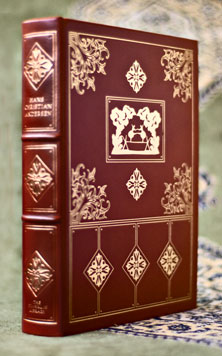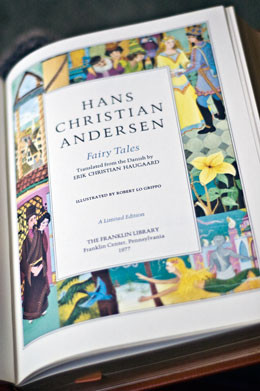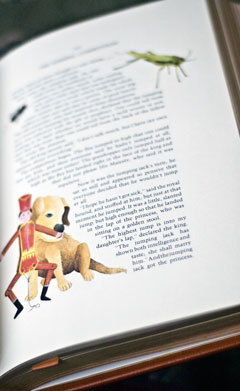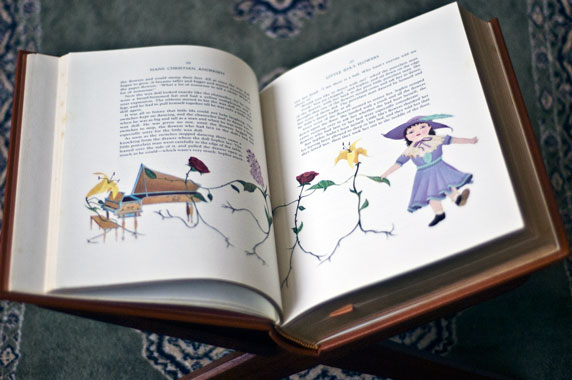Title: Fairy Tales
Author: Hans Christian Anderson, Erik Christian Haugaard (trans), Robert lo Grippo (illus)
ISBN: –
Publisher: Franklin Library, 1977. Limited edition, from The Collected Series of the World’s Greatest Writers.
Condition: Hardcover, full brown leather. In fine condition. 543 Pages. Very large and heavy.
About the edition:
A beautiful collector’s edition, this book features:
- Full brown top-grade leather binding
- Genuine 22k gold gilt to all edges, front design, spine, and back
- Silk moire endsheets
- Satin bookmark, sewn-in
- Hubbed spine with 2 raised bands
- Smyth-sewn binding for durability
- Premium acid-neutral archival paper that will not yellow
About the book:
Hans Christian Andersen’s fairy tales have become so much a part of our consciousness that we tend to overlook their creator, a man who lived only a century ago, and who counted among his friends the great English novelist Charles Dickens, and the composers Liszt, Schumann and Mendelssohn. His celebrity and immortal association with the fairy tale genre have had a tendency to cloud the facts of his singular personal life. Andersen continues to be known as the man who created “The Ugly Duckling,” “The Princess and the Pea,” “The Snow Queen,” and other classic stories that have become the alphabet of childhood.
It is easy to forget that Andersen’s stories, unlike those of Aesop or the Grimm brothers, are not dependent on folk tales, but are the work of the author’s marvelous imagination. From beautiful princesses in far-away palaces to fanciful animals and mermaids, we avidly follow the fantastic path drawn by Andersen’s pen. The ease with which child and adult alike fall under his spell attests to Andersen’s unparalleled skill as a storyteller. He has created, beyond simple children’s stories, fine, jewel-like works that touch upon universal concerns. Andersen’s fairy tales have endured the harsh review of time, and will continue to be read with wonder and delight by all generations.
Hans Christian Andersen was born in 1805, in the Danish city of Odense on the island of Fyn. His parents were poor (his father was a shoemaker and his mother, a washerwoman) and unable to provide him with what they considered an adequate education. When he was twelve, Andersen’s father died, and Hans was forced to take a job in a factory in Odense. But Andersen knew he could not sustain a life as a factory worker. At the age of fourteen, he quit his job and left Odense for good. He sailed for Copenhagen, having decided he would try to make himself a success as an actor and singer in the theatre.
Good luck found Andersen from the moment he arrived in Copenhagen – the city opened itself up to him as though it were a jeweled box in the hands of a charmed country boy. Andersen happened into a circle of powerful and wealthy men who became his patrons and mentors, and as he began to know the city better, he met a number of influential persons who would become his lifelong friends. Andersen received a royal grant, which provided him with money to further his education, and he won admittance to the University of Copenhagen in 1828.
By his fortieth birthday, Andersen had come to realize that his genius with words lay in writing fairy tales, so for the rest of his life he devoted his energies to them. His spreading international fame furthered a great respect and admiration for him within Denmark. He was credited with initiating a single-handed renaissance in Danish letters, and with the stabilization of the Danish language, whose integrity some saw as endangered from the vitality and profusion of its German-speaking neighbors to the south. Andersen’s writing was also seen as exemplifying the essential characteristics of the Danish people: a fierce democracy and a certain cheerful tolerance.
Andersen had this to say about the genre of the fairy tale:
In the whole realm of poetry no domain is so boundless as that of the fairy tale. It reaches from the blood-drenched graves of Antiquity to the pious legends of a child’s picture-book; it takes in the poetry of the people and the poetry of the artist. To me it represents all poetry, and he who masters it must be able to put into it tragedy, comedy, naïve simplicity, and humor; at his service are the lyrical note, the childlike narrative and the language of describing nature.






